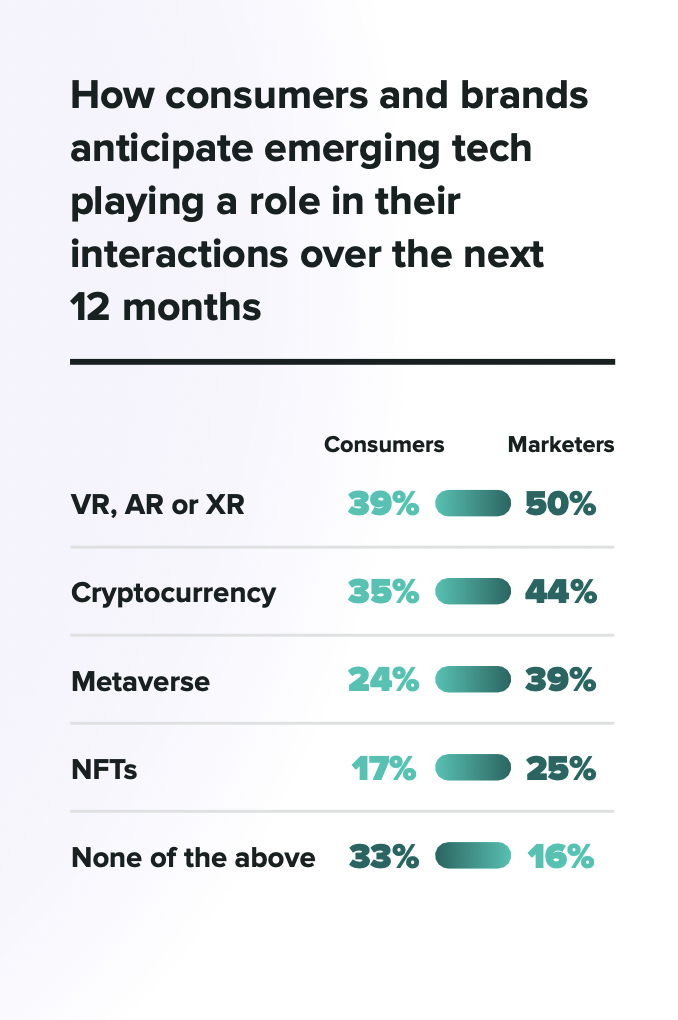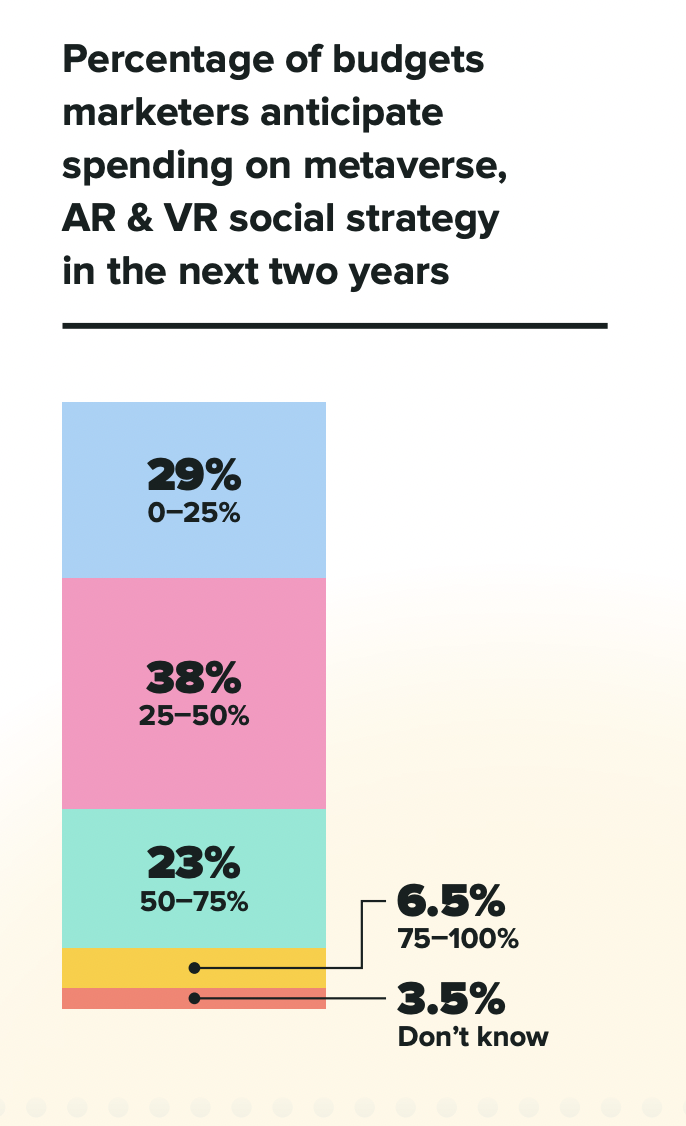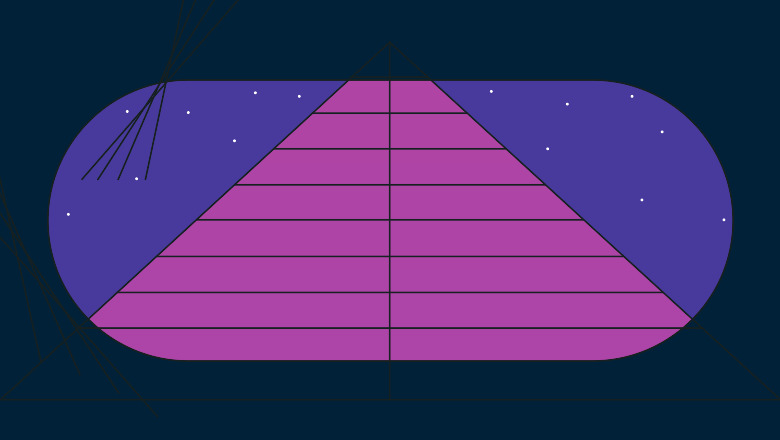The Metaverse: What it is and why it matters for brands
The pandemic ushered in a new era where the virtual and physical worlds coexist, so it’s no surprise the metaverse has been a buzzword on the internet over the past few years. But what exactly is it? Is it Mark Zuckerberg’s latest big idea, or a techie's newfangled dream? Or is it something brands can genuinely take advantage of?
The short answer is yes. The metaverse is projected to become an $800 billion market by 2024 and tech giants are already investing millions to make this dream a reality. Major companies and startups alike are becoming early adopters, collaborating with metaverse companies to create branded activations and more. If you’re reading this article, you probably want to learn more or are already thinking about joining the metaverse. Before you embrace these trailblazing opportunities, you should fully understand what the metaverse is and what it means for the future.
What is the metaverse?
Well, the metaverse is truly the stuff of your favorite sci-fi fantasy thriller coming to life. If you’ve ever watched Ready Player One or an episode of Black Mirror, you’ve probably seen some similarities to today’s metaverse.
To put it simply, the metaverse is an all-encompassing term that refers to immersive, hyper-realistic virtual environments where people can interact via personalized avatars.
The term “metaverse” was coined in the 1992 novel, Snow Crash. The book described the metaverse as a digital world that exists parallel to the physical world, with the ability to visit virtual spaces at will. Talk about life imitating art, right?
The metaverse doesn’t refer to one singular type of technology, but rather a group of technologies that will shift how we interact online. The metaverse is part of web3, which is basically the next iteration of the internet. The internet we know and love today—social media, apps, live streams, e-commerce—is known as web2.
Web3 is also difficult for people to wrap their heads around because it’s complex and comes with its own set of jargon (blockchain, crypto, NFTs, etc.). In short, web3 is the decentralized internet. Instead of tech giants like Google or Apple controlling the internet, everyday users will own, operate and contribute.
Some proponents say the metaverse will mimic the physical world entirely and a new digital economy will emerge. Users will buy real estate, sell and own goods, host parties, educate scholars and even get married.
However, there are several types of tech that currently fall underneath the umbrella term. These include, but are not limited to, the following:
Extended reality (ER) – another umbrella term encompassing virtual reality (VR), augmented reality (AR) and mixed reality (MR)Virtual worlds created by metaverse users (e.g., Decentraland)Massively multiplayer online games (MMOs), like Fortnite or RobloxDecentralized autonomous organizations (DAOs)Assets like cryptocurrency and NFTs (although some NFT advocates say otherwise)HologramsVideo callsAvatarsDigital and augmented reality concertsPublic blockchainsPhotogrammetry – the process of creating digital 3D objects out of photos or video (e.g., Capturing Reality)Tech companies and enthusiasts have varying visions for metaverse technologies, along with nuanced opinions, because they’re still a work in progress. It can develop into something we can’t completely fathom because we’ve never seen it.
It’s like the early days of the internet and social media—we knew they were impressive innovations, but we didn’t know they would become an integral part of culture and business. These ideas swelled into something bigger than our imaginations and the metaverse is the same way.
Now that you have a general idea of the metaverse, let’s dive deeper into two key aspects of understanding the future: common traits of a metaverse and interoperability.
Who created the metaverse?
Although Meta (formerly known as Facebook) made the metaverse a household name, the tech company did not invent the idea. The road to today’s metaverse—and the one of the future—was paved by several different trailblazers far earlier.
As mentioned above, the term metaverse was coined in 1992 by Snow Crash and it features some spot-on predictions of Meta’s plans. Some technology described in the book already exists too. The main character appears as an avatar in the metaverse, which he accesses through goggles and earphones. That’s reminiscent of today’s augmented and virtual reality glasses/headsets, but there are differences as well.
Hyperlinks, e-mail, messaging, digital photography and video are some of the building blocks that led us to Web2. The metaverse’s foundation includes the birth of Bitcoin, virtual communities, MMOs and extended reality devices. These are some of the building blocks that led to companies announcing their plans for the metaverse in 2021.
What common traits do metaverses currently have?
The metaverse is multifaceted and multidimensional. However, some characteristics define a metaverse. Here’s what they are and what they mean:
1) A metaverse is always active
A metaverse doesn’t pause or end when you exit the platform. In a traditional video game, you can leave and return to where you left off. A metaverse is infinite, the world never stops, even when you go offline.
2) A metaverse exists in real time
Metaverses sync with time in the physical world. Conversations and actions can happen in real time, regardless of where you are in the community.
3) Metaverse users have agency
Users can explore a metaverse at their own free will. They have the freedom to do and say what they want. For example, in MMOs, various players can perform different activities at the same time.
4) A metaverse exists as its own universe
As a virtual world, a metaverse functions as its own universe, with unique features, frameworks and rules. For example, users can create, sell, own and invest on metaverse platforms. They are rewarded for their life in the metaverse, making the experience emulate the physical world even more.
5) User-generated content is valued in the metaverse
Users on metaverse platforms can create original content for others to enjoy. Remember that decentralization is a core component of web3, so user-generated content goes hand-in-hand with the metaverse. There are also online communities like Decentraland that were created by the users themselves.
6) A metaverse can exist across multiple platforms
Video games like Roblox and Fortnite are great examples of metaverses existing across several platforms. Players can enter these metaverses on a variety of devices such as PCs, tablets and smartphones. In the future, these various platforms will work together seamlessly, which brings us to one of the biggest challenges of the metaverse: interoperability.
The interoperable metaverse explained
Interoperability is a fancy word for the ability to take virtual items, like clothes or houses, from one metaverse platform to another. It refers to the systems, protocols, rules, applications and technologies that enable users to travel seamlessly between metaverses.
The interoperable metaverse is an extension of the vision Meta, Microsoft and others are pursuing to make a reality. However, transferring virtual items from one world to another is a complex task that no company has been able to address for several reasons.
This lends the question: How will we approach user interface and experience in a 3D world that runs parallel to the physical? And how do we achieve that if the technology and computing power required is something no one has ever built?
The metaverse itself isn’t one single product or system, but an interconnected system of technologies, platforms and products that requires a lot of computing and engineering resources. It also isn’t owned by one entity. Individuals and companies across various sectors will have to work together to reach interoperability. Companies will have to work with their competitors like peers as opposed to rivals.
Businesses will also have to consider how to remain profitable in a space catered to decentralization. Tech companies, in particular, will have to balance profitability with the resources required to reach this ideal metaverse—which could take several years. Meta announced in April 2022 that the groundwork for this to happen will be in place by 2030.
Interoperability is just one of the few hurdles that arise within metaverse discussions. But let's look at the opportunities that already exist for brands in the near future.
The future of metaverse marketing
According to The 2022 Sprout Social Index™, marketers were the early metaverse adopters while consumers weren’t as eager. Overall, marketers are more likely than consumers to anticipate the metaverse and other emerging tech playing a role in their interactions over the next year.

How to invest in the metaverse
Metaverse marketing allows you to tap into a niche audience, expand your brand’s reach and sell products in a new arena. The metaverse is still growing, but early investors are already seeing results in other ways.
More than two-thirds of marketers anticipate investing at least a quarter of their budget into metaverse tactics over the next 12 months, with 33% of marketers believing their brands are ahead of the curve for implementing AR/VR into their social strategy.

The gaming industry is one of the first to take advantage. Fortnite and Roblox are some of the largest metaverses, offering brands the opportunity for impactful collaboration, especially those that target Millennials and Gen Z. You can use these existing environments to engage with your target demographic groups, all the while promoting your brand in an authentic way.
Even though marketers are ready for the next big thing in tech, it’s important to strike a balance between meeting customers where they are and showing them what lies ahead in the future.
How to join the metaverse
There are several ways you can use existing technology to join the metaverse. If you want to experience the metaverse as an individual, consider investing in XR wearables such as Oculus Quest 2, Valve Index VR and Google Cardboard or Glass. These wearable devices offer a range of opportunities from gaming and entertainment to virtual workspaces.
Here are a few ways your brand can get involved in the metaverse:
Engage on digital platforms such as Roblox, Fortnite, Decentraland and Meta Quest 2Connect with customers via metaverse elements such as NFTs and virtual eventsCreate engaging content users can unlock through NFTs or mini-gamesShare thought leadership content via avatars on metaverse platformsBuild immersive experiences for your audienceTie your metaverse activations to real-world efforts (e.g., physical merch, prizes)Many companies are already hosting brand activations in the metaverse, so don’t hesitate to research and explore existing environments to help brainstorm metaverse ideas for your brand.
Brand activations in the metaverse
Here are a few examples of brands who have joined the metaverse:
Gucci
Gucci’s clothing isn’t the only part of the brand that’s fashion-forward. The luxury fashion house has done several activations in the metaverse over the past two years. In early 2021, the brand released the Gucci Virtual 25, a digital sneaker that can be worn in AR or through apps like Roblox and VRChat.
The sneaker release was followed by Gucci Garden on Roblox, where players purchased exclusive designer pieces, like the Gucci Dionysus Bag with Bee. This bag was resold for over $4,100 worth of Robux, Roblox’s in-game currency, surpassing the cost of the actual physical bag. The virtual garden was a complement to a real-world installation called the Gucci Garden Archetypes, located in Florence, Italy.
The brand launched its latest metaverse activation, Gucci Town, in June. Gucci Town is a permanent space in Roblox where players can learn more about the brand, and express their style through virtual outfits.
@valerie_444v♬ #BrooklynBloodPop! ' SyKo

The Metaverse is not just a technological concept; it's an entirely new landscape that redefines brand-consumer interactions and creates unparalleled opportunities for brands to engage in immersive, multidimensional experiences.














